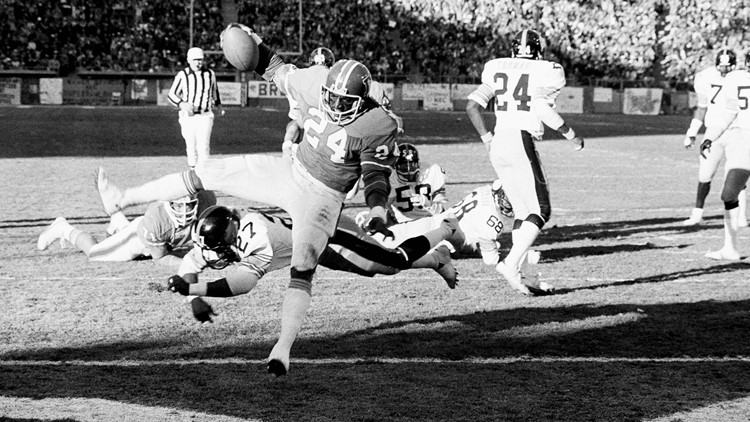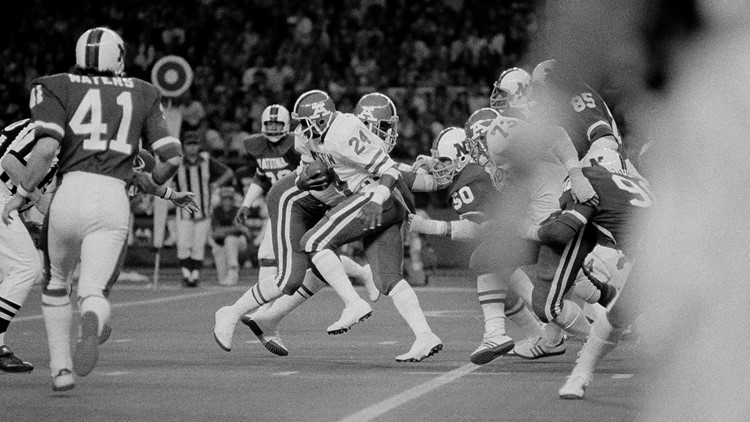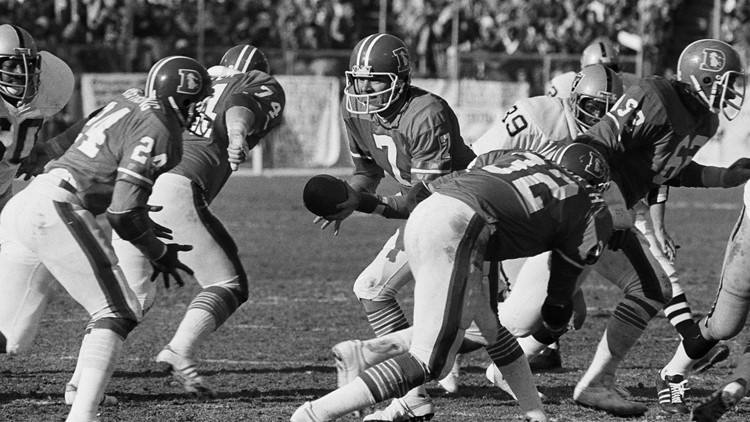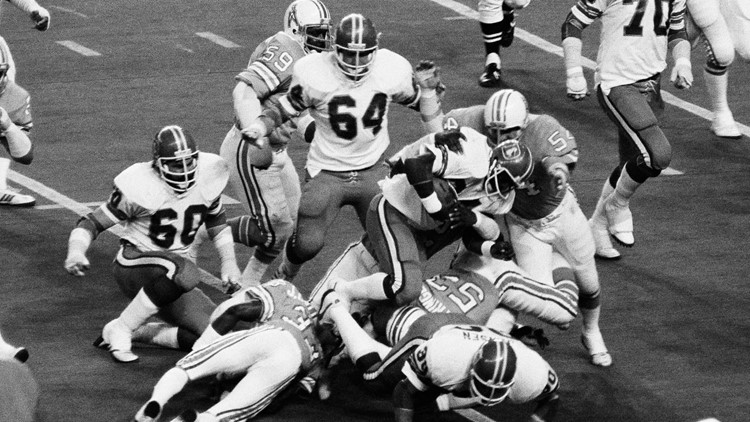ENGLEWOOD, Colo. — Otis Armstrong, who followed, then joined Floyd Little as the two greatest running backs through the first two decades in the history of the Denver Broncos' franchise, has died.
He was 70 years old.
Broncos alumni received the news via e-mail Friday morning that Armstrong passed away Wednesday night while surrounded by his wife Yvonne and family.
"It's a very sad day,'' said Haven Moses, the Broncos' top receiver in the 1970s and Armstrong's teammate. "Otis was a very special person. We had a very close team. Otis was a wonderful teammate, a wonderful running back. He'll definitely be missed. He was part of a Bronco era that laid the foundation for the team's success today."
Marv Montgomery was an offensive tackle for the Broncos from 1971-76.
"I was thinking back to 1973 when Otis came to camp in his first year,'' Montgomery said. "I always remember how he ran. He was always on his toes. It was like a butterfly moving through the line. He had a very interesting way of running."
Little died on January 1 at 78 years old so the Broncos have lost their first two great running backs in the span of 9 1/2 months.
For the book "50 Greatest Players in Denver Broncos History," published in 2017, Armstrong received the special distinction of being rated as the 50th greatest Bronco. Here is the chapter on Armstrong from that book:
No. 50: Otis Armstrong
He was drafted in the first round with the idea of becoming heir apparent to The Franchise. That’s all.
“That is true, except Floyd had other ideas,” Otis Armstrong said with a small laugh at the memory.
When it comes to following legends, Armstrong learned there is no such thing as getting used to it. He left Farragut Career Academy High School on the West Side of Chicago for Purdue in 1969. The year before, the Boilermakers running back was Leroy Keyes. Other than USC’s O. J. Simpson, there was no bigger college-star running back than Leroy Keyes.
In fact, in 1968, Simpson and Keyes finished 1-2 in the Heisman Trophy balloting.
Armstrong made his own name at Purdue, rushing for 3,315 yards and adding another 389 yards receiving in just 31 games. In those days, college teams only played 10 or 11 games a season, and freshmen couldn’t play.
Armstrong was sensationally fast—so much so that he was a first-team All American along with Oklahoma running back Greg Pruitt. Again, this was a time when the All American team meant more than whether or not a college player was considered first-round caliber.
Otis Armstrong
Armstrong was ready for the NFL in 1973 when the Broncos made him the first running back selected, No. 9 overall, in the draft. Only Floyd Little wasn’t ready to surrender his mantle as The Franchise, a nickname he was given when he became the Broncos’ first, first-round draft pick to sign with the American Football League franchise in 1967.
Armstrong played in every game his rookie year of 1973, but only had 90 yards on 26 carries. Little finished ninth in the NFL, with 979 yards rushing in the 14-game season, and tied Simpson with 12 rushing touchdowns—the same year Simpson rushed for 2,003 yards.
Armstrong, it seems, was always following a legend.
“Isn’t that the truth?” he said from his home in the Denver suburb of Centennial in February 2017. “Everywhere I’d go, I was moving somebody out who everybody loved. I wanted everybody to get a chance to see me for who I was. It was hard when everybody was saying ‘Leroy Keyes was my favorite guy!’ [or] ‘I loved Floyd Little!’ ”
“It wasn’t easy for Otis,” said Rick Upchurch, a rookie in Little’s final season of 1975. “Floyd was a fan favorite, and he helped keep this team here. That was like trying to follow Muhammad Ali into the ring.

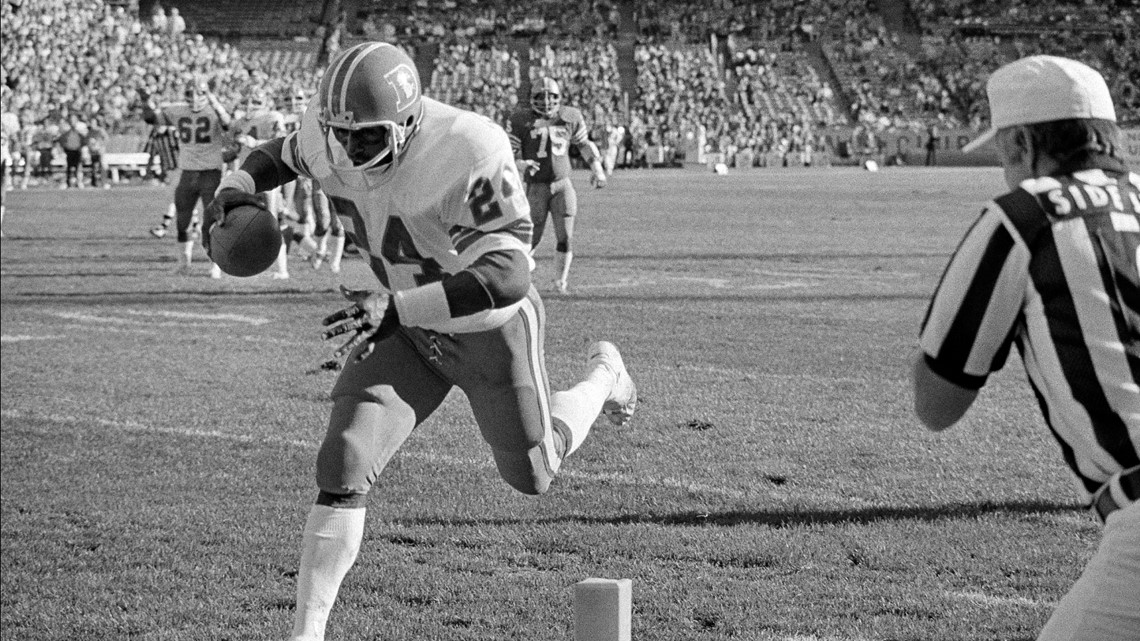
“But, Otis always wanted to be the man. He would say, ‘Put the ball in my hands, because I want to do some damage to these bums.’ He used to call the other team, ‘bums.’ He was very inspiring. A hard worker.”
In his second season of 1974, Armstrong became the man. He led the NFL in rushing with 1,407 yards on 5.3 yards per carry. The key was his finish. He had 792 yards through his first 10 games, then ran wild in his final four games. He picked up 146 yards against the Oakland Raiders, 144 against Detroit, 183 against Houston, and 142 against San Diego. That’s an incredible 615 yards on 6.03 yards per carry in those final four games.
It was the best rushing season in Broncos history, and held up as a single-season record for 24 years, until Terrell Davis rushed for 1,750 yards in the Broncos’ first Super Bowl–title season of 1997.
“That was a big surprise, because I was just happy to be playing,” Armstrong said. “All of the sudden my name was in the paper. I had a good line, I really did. We had Paul Howard. They got me started.”

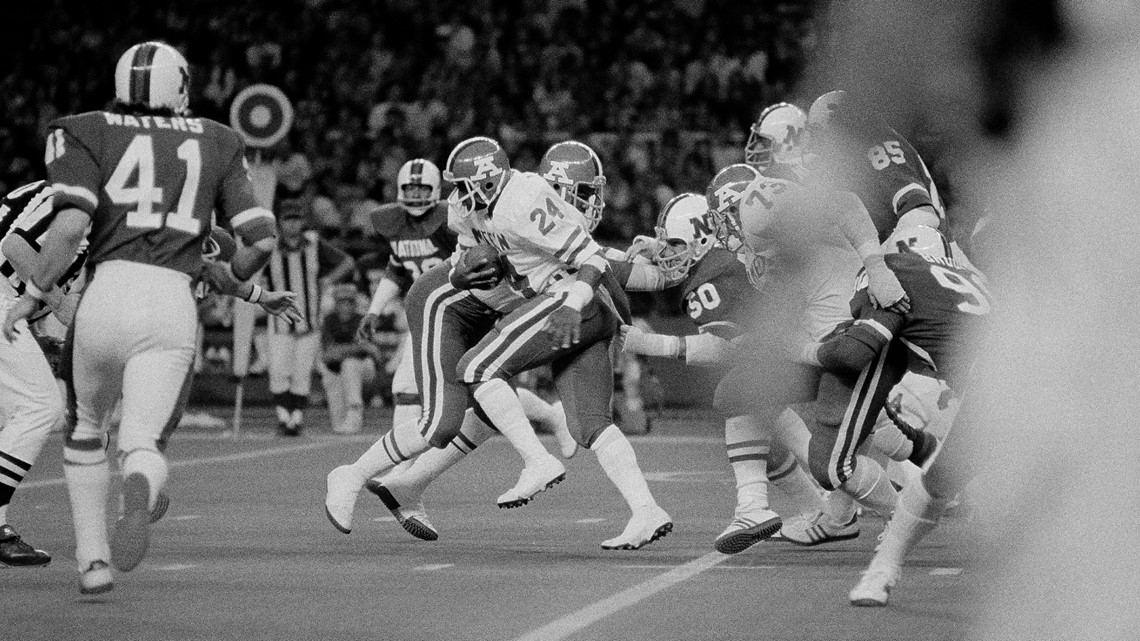
Armstrong grew up on Chicago’s West Side, across the street from Franklin Park.
“Played there every day growing up,” Armstrong said. “We played basketball, football, every day we played something.”
He had five older brothers and two sisters. John Armstrong, the dad, was a mechanic, and Rosie Lea Armstrong was a stay-at-home mom.
“My brothers played before me, so that’s why football became my cup of tea,” Armstrong said. “The neighborhood where I grew up, it was nice back then. Things deteriorated a little bit, but the people are strong. They get through it.”
At Purdue, Keyes had just left when Armstrong showed up on the West Lafayette, Indiana, campus for his freshman season of 1969, but he did get to practice with quarterback Mike Phipps, who became the second Boilermaker in two years to finish second in the Heisman balloting. (Oklahoma running back Steve Owens won the top college player award.)
Armstrong’s Heisman experience was strange. He rushed for more than 1,000 yards as a sophomore in 1970 (1,009 in 10 games), and as a senior in 1972 (1,361 in 11 games), yet the only time he finished in the top 10 in the Heisman voting was as a junior, when he had 945 yards.


Truth is, following Little in Denver wasn’t a problem. Armstrong considered Little his mentor.
“I did everything he did,” Armstrong said. “I tried to copy Floyd as much as I could. It worked out really well for me.”
After Armstrong’s sensational season in 1974, he tore his hamstring four games into 1975.
“That’s how Floyd got his glory at the end,” Armstrong said.
Little came off the bench and had such an inspiring finish, he got carried off the field after his final home game at Mile High Stadium.
The greatest draft class in Broncos history? Their 1973 draft has to be in the top five. There was Armstrong in the first round, Barney Chavous in the second round, Paul Howard in the third, and Tom Jackson in the fourth.
That 1973 season was also when the Broncos started winning. The team had suffered 13 consecutive non-winning seasons until it turned in 1973. The Broncos went 7-5-2 in ’73, 7-6-1 in ’74, 9-5 in ’76, and 12-2, with two more playoff wins, to reach the Super Bowl in 1977.

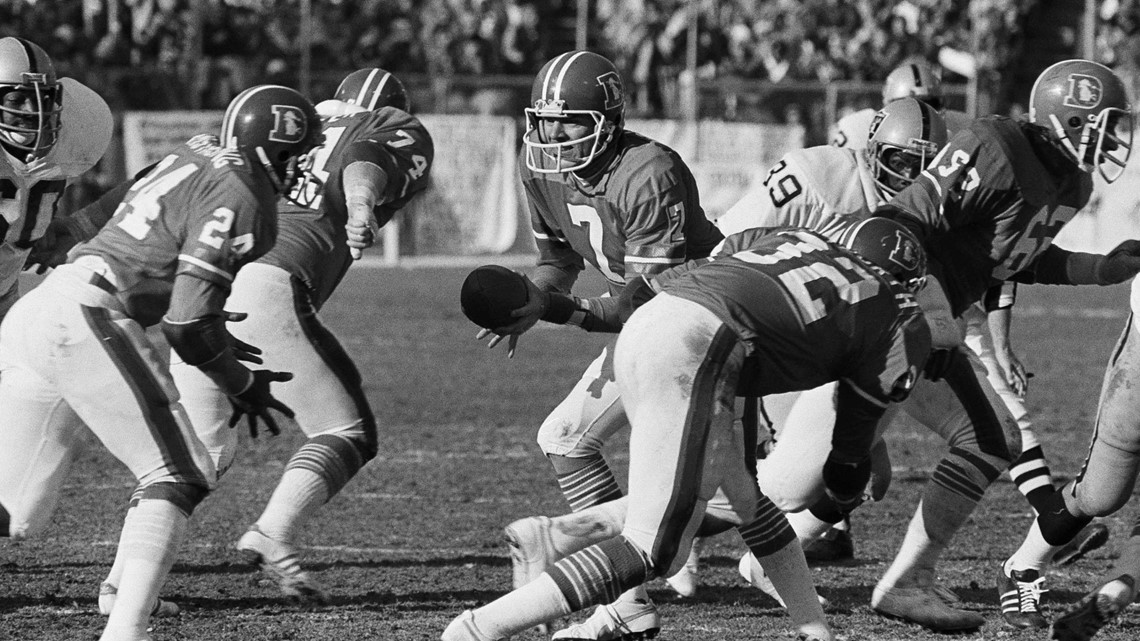
Armstrong had a second, 1,000-yard rushing season in 1976, but he said the team’s trip to the Super Bowl was the highlight of his career.
“I missed the last four games that year with a sprained ankle, but I came back for the playoffs,” Armstrong said. “I scored a big touchdown against the Steelers.”
It was a 10-yard scoring run that put the Broncos up, 14–7. He also had a 29-yard run in that game and the Broncos won, 34–21, to advance to the AFC Championship Game.
“We were kind of surprised we beat the Steelers, but it happened,” Armstrong said. “We were pretty good at home.”
At 5-foot-10, 196 pounds, Armstrong struggled to stay healthy as the NFL went from 14 to 16 games in 1978, and the Broncos went to a running-back rotation that also featured Jon Keyworth, Rob Lytle, and Lonnie Perrin.
“Otis was my running mate,” Upchurch said. “Otis was everything I wanted to be. I was a running back coming out of college, but I saw this guy and . . . he was my roommate, and the punishment he would take, I said, ‘Nah, that’s all right. You stay at running back, I’ll stay out here at receiver.’ ”
Armstrong’s final blow came on his 1,023rd and final carry of his eight-year Broncos career. Houston defensive star Elvin Bethea drove him into the Mile High Stadium turf, leaving Armstrong with a neck injury. Doctors discovered a narrow passage in Armstrong’s upper spine and recommended he never play football again.

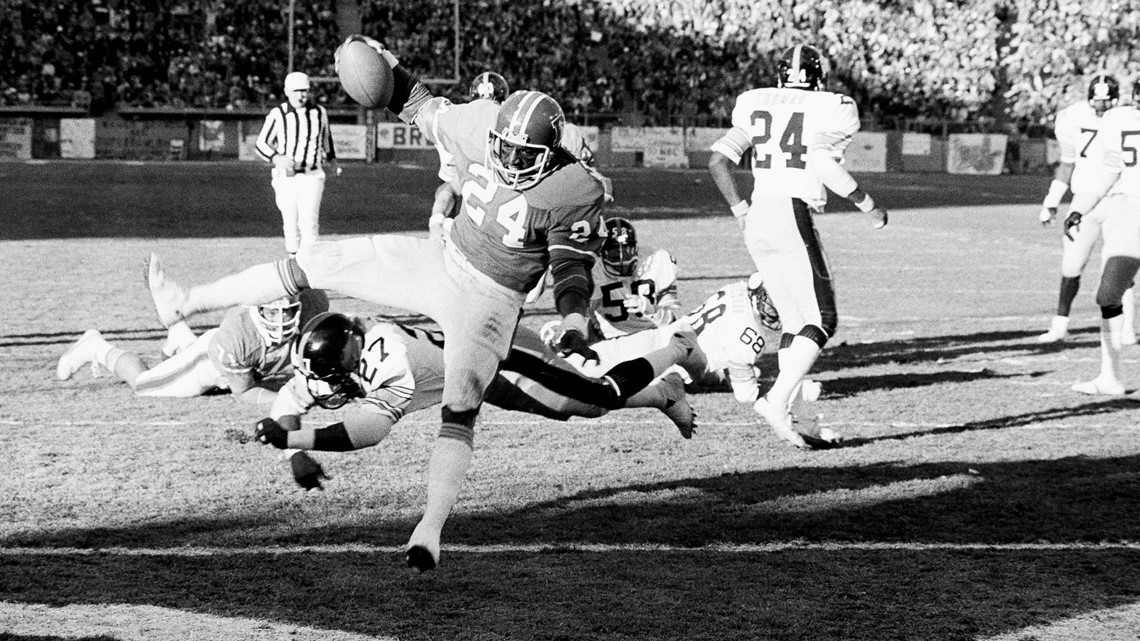
He retired as the Broncos’ second-leading all-time rusher.
When he was finished, Armstrong and Keyworth went into business together, first as beer distributors, then for vitamins.
Armstrong was 66 years old at the time of his writing, and though he was inducted into the College Football Hall of Fame in 2012—Little showed up for his enshrinement ceremony in South Bend, Indiana—he is hoping to become a member of the Broncos Ring of Fame.
“I had a nice following when I played,” he said. “I think I deserve a mention.”
He is among the 50 Greatest Players in Broncos History.
Broncos podcast: Klis' Mike Drop
Denver Broncos headlines, game previews and interviews with our 9NEWS insider Mike Klis.
HOW TO LISTEN
> Top stories curated daily just for you! Sign up for the 9NEWSLETTER to get can’t-miss stories, Next and Broncos content, weather and more delivered right to your inbox.
SUGGESTED VIDEOS: Sports
MORE WAYS TO GET 9NEWS
Subscribe to our daily 9NEWSLETTER
Download the 9NEWS APP
iTunes: http://on9news.tv/itunes
Google Play: http://on9news.tv/1lWnC5n
HOW TO ADD THE 9NEWS APP TO YOUR STREAMING DEVICE
ROKU: add the channel from the ROKU store or by searching for KUSA.
For both Apple TV and Fire TV, search for "9news" to find the free app to add to your account. Another option for Fire TV is to have the app delivered directly to your Fire TV through Amazon.

